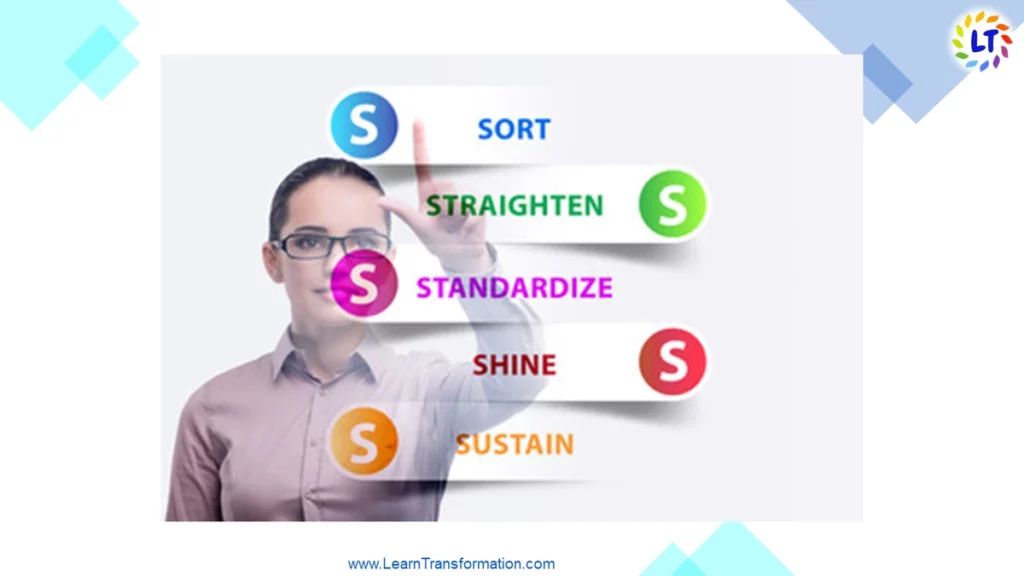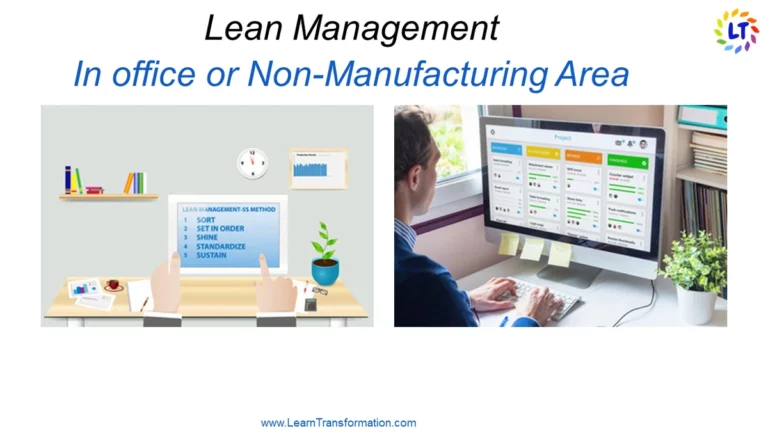There is nothing so useless as doing efficiently that which should not be done at all.
Peter F. Drucker.
Lean manufacturing has been there for quite some time. In manufacturing, Lean is defined as an organized approach to identifying & removing waste (non-value-added activities) in Lean office Transformation via continuous improvement by developing the product only when the consumer wants it (referred to as “pull”) in chasing perfection.
Unlock a world of knowledge with just one click: Navigating Lean Digital Transformation
Lean Office
Lean was originally developed for manufacturing, why stop there? Many lean methods used in lean production straightly apply to the office environment. Lean office aims to “streamline & remove waste from administrative processes and adding value.” The office gets information, operates on it & modifies it into another form of information; this is no different from any other form of manufacturing. Keep in mind that wherever there is a business system one can apply Lean. Lean Office concentrates on figuring out & performing the proper administrative activities with the right processes.
Lean Demonstrates Itself in The Following
- Reduction in cycle time.
- Reduction in touch times.
- Reduction in lead times.
We can use it across functions such as marketing, credit, sales, customer services, back-office, front-office, operations & product development. Lean Office is not only 5S. Mostly there is confusion about the fact that you have a Lean Office when you have done the 5S. This is inaccurate if you only doing 5S in applying Lean in the office. Assuredly the 5S is substantially crucial and is the base for a Lean Office, however, it’s far simply the preliminary point.
You have to focus on the process & find where the 8 wastes are in your tasks. These 8 wastes are over processing, defects, overproduction, waiting, transportation, unnecessary inventory, motion & skills. The lean office principles reduce human effort, investment & working hours. They modify how work is done, and thus increases results.
Lean principles practiced in the office are not about ‘withdrawing all the interesting bits and modifying staff into robots, but basically about eliminating waste so that employees can spend more time on creative or thoughtful steps that add more value to the customer.
A lean office management leads to many employee advantages. There is scope for cross-functional worker training, consistent progress, more responsibility integrated with increased contentment. The customer benefits of a lean office systems are also numerous. As in today’s time, the customer is the king, a lean office delivers fewer faults, increased flexibility & quicker service. All of these lead to greater customer satisfaction.
How to Make an Office Lean?

A. 5S in Office
5S is about making a lean office more systematic by eliminating all of the redundant mess up, outlaying the rest of the items ergonomically & safely, and maintaining and consistently improving these changes. If you are new to the 5S System, the first three steps Sort, Straighten & Shine are essentially housekeeping measures.
Hanpicked for You: 5S & 7S- A must require for Lean Transformation
1. Sort
The Sort step should include a plan for both sorting events & regular habits of employees. Sort means to distinguish between the necessary & unnecessary.
As we have often old samples, old documents, files, catalogs, and a lot of mess up on desks, and normally taking up space. Keep only the important items. The store often-used items close to the workstation. Store seldom-used objects farther away. Red tag any items that cannot easily be removed if they are not needed or not functioning. After removing the obvious mess up, review the rarely used items, if it is something which is needed then keep it in the area where it is needed, if it could be archived do so, and so forth for each.
2. Straighten
It means, “There should be a place for everything & everything should be in its place.” Arrange important items for easy access to lean office training. Here you focus on functional storage & eliminating the need to look for things. You can Color code documents & so on for particular regions of work which include making all consumer order documents blue, supplier documents red, etc., This will make it straight away clear.
There are some practice tips:
- Delete old & obsolete information from notice boards, intranet & the shared drive.
- Archive electronic files.
- Label all storage areas.
- Define filing standards.
Also See- What is OEE (Overall Equipment Effectiveness)?
Leader’s Tip
Leaders should concentrate on developing a continuous improvement culture and provide staff members the authority to find and fix inefficiencies.
3. Shine
The Shine step is all about keeping things clean. Assign responsibilities & define exactly what needs to do.
- Practice tips for Shine include:
- Inspect equipment & tools while cleaning.
- Divide office areas into zones & assign responsibility.
- Repair faulty equipment, e.g. creaking office chairs.
4. Standardize
The Standardize step of the 5S System is about your lean office systems. Further, It provides guidelines to maintain an organized office. Furthermore, If an employee has to walk 600 feet to get something they regularly use, find a way it can shift closer. So, The standardized step can be a framework for a complete process & quality management system.
5. Sustain
Sustain step is the final & essential step in the 5S lean office system. No matter how well outlaid the plan is it must be sustainable. Additionally, Sustain means to make 5S a habit & teach other to stick to established standards. So, Make sure that new employees are trained in the principles of Lean manufacturing & 5S and fully understand how they can contribute to the functioning of the company as a whole.
Check out the Video
B. Value Stream Mapping
To sustain Lean office management, it has to see to deliver results. The maximum considerable improvements are going to arise when you enhance the primary processes taking place in the workplace and the manner to do that is to perceive those value streams and focus first on improving them. Hence, This means making improvements to the way regular tasks completes, which means improving the key value streams in the office.
Handpicked Just For You: Value Stream Mapping for Manufacturing and Non-Manufacturing
Value stream mapping lets in for lean office processes to be regarded of their entirety, from the instant the consumer places the order to while a product is shipped. When carrying out the mapping, it’s necessary at least one person, or ideally, a small team walks the complete value stream to get a precise picture, instead of one compiled by teams each experiencing a small snapshot of the stream. Data about times & where backlogs occur is also important.
After this, apply the lean principles to remove wasteful processes such as unnecessary approvals & paperwork.
C. Identify types of Waste in Office
We have 8 types of waste mainly, which is also known as downtime. So, These 8 wastes are over processing, defects, overproduction, waiting, transportation, unnecessary inventory, motion & skills.
Leader’s Tip
Make investments in training and development initiatives to foster teamwork among employees and improve their critical thinking abilities.
Example of Implementing Lean Office
Human Resource
- Human Resources often advise the rest of the business on how to enhance their processes. Furthermore, Within Learn Transformation itself, we are applying Lean Office techniques to decrease the lead time & standardize the process of onboarding new employees.
Sales & Customer Service
- Customer-facing functions are often the last to see Lean improvements. This is unexpected for the reason that the Lean office technique is so centered on generating value for the consumer. So, It can deliver more benefit to your business the closer you are to the end customer.
- At its most targeted, “Lean Sales” can mean applying lean office principles in the real process of selling. Further, This enables your consumers to apprehend how your product or service can generate value for them. Critical lead times such as quotation lead times, order processing lead times & customer inquiry response times can be dramatically improved. Thus, This results in happier consumers and much less stress in consumer service. At the same time streamlining these processes will reduce processing time and cost.
Also Read: Organizational Transformation : 5 Key Steps For Success
Finance Departments
- The accountants are often the most doubtful people in your business when it comes to Lean – until they try it themselves. Hence, There are vast opportunities to apply Lean Office approaches in finance. Core processes can be streamlined such as accounts payable & cash processing.
- Daily meetings & leader standard work can improve communication can help detect problems early in an environment where people often work silently all day at computer workstations. So, You can use red-green task boards to track the completion of daily, weekly & monthly tasks which is very useful in the finance department.
Conclusion
If businesses or industries are looking at how Lean can be implemented within their working environment, admin & office procedures need to be subject to Lean office thinking. If only the manufacturing & production lines are revolutionized, there will still be waste in the office and regions which will produce waste until they are appreciably modified, following a Lean analysis. So, Remember, lean isn’t much about the system. Certainly, It’s about the people.
4 Best Lean Principles Books
Global Reader’s Click Below:
- A Factory of One: Applying Lean Principles to Banish Waste and Improve Your Personal Performance
- The 12 Principles of Manufacturing Excellence: A Lean Leader’s Guide to Achieving and Sustaining Excellence, Second Edition
- The Lean Six Sigma Pocket Toolbook: A Quick Reference Guide to 100 Tools for Improving Quality and Speed
- The Lean Turnaround: How Business Leaders Use Lean Principles to Create Value and Transform Their Company
India Reader’s Click below:
- Lean IT – Principles to Practice: Toyota Way to Create Value for the Customer & Wealth for IT Organization
- Creating a Lean R&D System: Lean Principles and Approaches for Pharmaceutical and Research-Based Organizations
- Lean Principles and Application in BPO
- The Principles of Product Development Flow: Second Generation Lean Product Development
FAQs
What does lean in the office mean?
Lean in office aims to “streamline & remove waste from administrative processes and adding value.” The office gets information, operates on it & modifies it into another form of information; this is no different from any other form of manufacturing. Keep in mind that wherever there is a business system one can apply Lean. Lean Office concentrates on figuring out & performing the proper administrative activities with the right processes.
What does a lean office look like?
The lean office principles reduce human effort, investment & working hours by modifying how work is done, and thus increases results. A lean office management leads to many employee advantages. There is scope for cross-functional worker training, consistent progress, more responsibility integrated with increased contentment.
Key Takeaways
- Key takeaways: a) Use lean ideas like value stream mapping and visual management to spot and get rid of tasks that don’t provide value.
- Encourage staff engagement and participation in lean efforts to promote long-lasting progress.
- Make use of technology and digital tools to streamline workflows, automate processes, and improve communication in the workplace.

